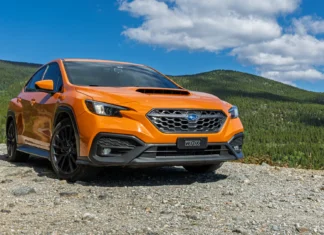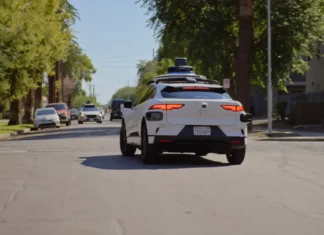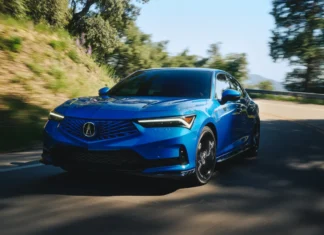The Mini Cooper has been pegged as a city scooter forever. Its small wheelbase makes it easy to park and zip through tight city streets. And it does it with flair and go-kart like fun at a bargain price. So it makes sense that the company introduced the Mini Cooper SE with only 110-miles of range. The 32.6 kWh-size battery helps reduce the price of the vehicle, keeping it to $29,900 for the base model. Plug in federal and state tax incentives and, here in Colorado, that pushes the final cost of the Mini SE below $20K, making it the least expensive EVs available right now. (Our test model, however, was optioned to the nines and stickered for $37,000.) Plus, that range is well north of the 30 miles per day that many EV producers tout as the average daily miles covered by American drivers.
TFLcar’s Loveland Trials
Our Loveland Trials test is simple: An 148-mile out-and-back route from Boulder, Colorado, up I-70 to the top of Loveland Pass, at 11,990 feet above sea level. The 74-mile climb to the top is well within the SE’s EPA range, except that it involves more than 7,000 feet of range-munching ascent. On the way down, we test an EV’s regenerative abilities to recharge its battery to see if it stores enough juice to make it all the way back to Boulder.
This time, though, we brought a comparison Mini, Tommy’s personal 2010 Mini Cooper S John Cooper Works, to compare three aspects of the SE to its older gasoline-powered cousin.
- Range – How much electricity vs. gasoline each Mini used.
- Cost of Fuel – What it cost in dollars for each vehicle to make the trip.
- Cost of Time – How much it takes to refuel/recharge each Mini.
Mini Cooper EV vs. Mini Cooper JCW
Mini’s EV basically pulls the powerplant and drivetrain from BMW’s i3 EV. It’s good for 181 hp and 199 lb-ft. torque. The JCW’s 4-cylinder turbo was rated to 200 hp when new, but that was 102,000 miles ago. Oddly, both Mini’s share the same 0-60 mph times of 6.9 seconds.
Mini SE: On the road, we started the SE with a full charge, which the car’s trip computer calculated out to equal 100 miles of range in Normal driving. mode. For the test, we drove the car in Green Mode, to optimize power application. However, we purposely DID NOT use Green+ mode. Why? Because that prevents use of the A/C or heat, and we don’t believe today’s driver is going to tolerate not using the A/C on a hot day or the heater when it’s freezing. Doing so cost us an additional 5 miles of range though.
Traveling up I-70 at the posted speed limit of 65 mph, the SE was averaging about 4mi/Kwh of juice. By the time we got to the top of Loveland Pass, the battery had 14 miles of range left. By comparison to the older, nimble feel of the JCW, the SE felt planted, heavier, and more “BMW-like,” no doubt helped by the hefty lithium ion battery seated between the wheels.
Mini Cooper S John Cooper Works
By comparison, the ten-year-old JCW turbo had no issues with the rarified air at 12,000 feet. Its turbo kept the Mini lively and a joy to drive. Unlike the SE, though, the gasoline-powered variant still had 400-odd miles of range at the top of Loveland Pass—the fuel gauge still registered as FULL.
Going Down
Now comes the second half of the Loveland Trials: the trip back down to see how much regen juice the Mini returns to the battery. By the time we hit the bottom of the hill 52 miles later in Golden, Colorado, the SE’s range was now 16 miles, or a total of 126 miles on one charge. Not bad, but not enough range to get us back to Boulder.
A stop at the nearest charging station was needed to get enough juice to get to Boulder, which is where our experience with the SE turned into a deal-breaker. Stopping at a Electrify America fast-charging station, we found most of the charging stations non-functional, and when we did finally get connected to the charger after 20 minutes of trial and error, it started charging the SE at half-capacity. So instead of a seamless, 30-minute experience to get the Mini 80-percent charged, we spent 30-minutes total to get just enough juice to get us back home.
Meanwhile the JCW’s trip computer was still showing 400-plus miles of range and a nearly full tank.
Final Results
After filling up the JCW with a little over 3.5 gallons of gas and plugging in the SE to our office’s Level 2 charger, here’s how our 3-point comparison came out:
- Range – The SE does as advertised, delivering more than its 110-mile range. Still, it couldn’t make the whole trip home, so it didn’t pass. We didn’t think it would, but we weren’t expecting to only gain 2 miles of range by the bottom of a 52-mile downhill. The JCW blew our minds, though, returning 41.5 mpgs, which we know from experience is phenomenal in the mountains. Winner: JCW
- Cost of Fuel – Even after paying Electrify America’s inflated rate to recharge the SE, the EV Mini ran the Loveland Trials for less money than the gasoline-powered Mini. Final tally was $6.92 for the SE to $9.38 for the JCW, which needs premium unleaded. Factor in the historic low prices for gas right now, and we believe that the gas Mini’s fuel costs would have easily doubled the EV’s in normal times. Winner: SE
- Cost of Time to Refuel – This is where the justification for the SE collapsed. We wasted 30 minutes trying to charge the EV on the road and even then we only spent enough time to get the battery charged enough to get us 20 miles home. The JCW took less than 3 minutes to refuel. Winner: JCW
While the SE didn’t better its older cousin in our Loveland Trials test, it’s still a worthy to consider for a 2nd or 3rd commuter car. If you have the ability to charge it to full every night and/or while parked at work, you could make the SE fit your lifestyle quite nicely. And for the price with incentives, you get a quirky, fun-to-drive car that doesn’t scream BORING! In so many ways, that’s what makes the SE a true Mini.
Click on the video below to see how each performed during The Loveland Trials, the world’s toughest EV test.






















